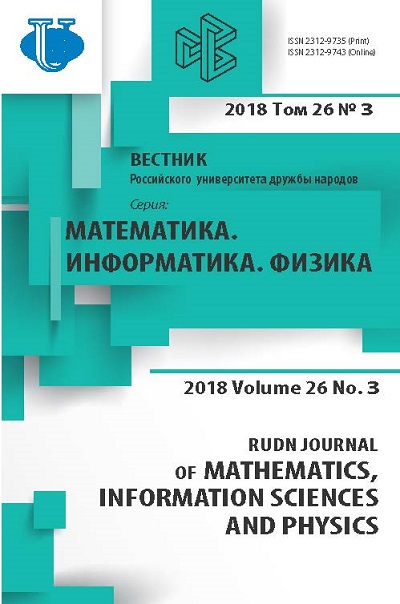RACH Session Initiation Procedure with Retranslations
- Authors: Semenova OV1, Vlaskina AS1, Medvedeva EG1, Zaripova ER1, Gudkova IA1,2
-
Affiliations:
- Peoples’ Friendship University of Russia (RUDN University)
- Institute of Informatics Problems Federal Research Center “Computer Science and Control” of the Russian Academy of Sciences
- Issue: Vol 26, No 3 (2018)
- Pages: 261-271
- Section: Computer Science
- URL: https://journals.rudn.ru/miph/article/view/18991
- DOI: https://doi.org/10.22363/2312-9735-2018-26-3-261-271
Cite item
Full Text
Abstract
Due to the rapidly growing number of user’s equipments, operating in the LTE (Long-Term Evolution) mobile radio network, it became necessary to find methods to reduce the user load and signaling message’s traffic. New rules and procedures of devices communication are created to downsize network resources. This article explores the procedure for establishing a connection between mobile user’s equipment and the LTE base station. Such possible solution of transferring small data generated by machine-to-machine connections (M2M, Machine-to-Machine) was presented in the technical report TR 37.868 of the 3GPP consortium (3rd Generation Partnership Project). This approach implies the use of the random access channel (RACH) to interconnect between devices. Effective usage of the procedure for establishing a connection through a random access radio channel is based on the analysis of time-probability characteristics, such as the access success probability and failed access probability, average access delay. In this article we proposed analytical model in term of Markov chain to find these characteristics and present numerical analysis, considering collisions of preamble message, retransmissions of signalling messages and the boundary conditions on the number of possible retransmissions. The accuracy of the proposed analytical model was verified using programming environment R.
About the authors
O V Semenova
Peoples’ Friendship University of Russia (RUDN University)
Author for correspondence.
Email: 1032163670@rudn.university
Student of Department of Applied Probability and Informatics of Peoples’ Friendship University of Russia (RUDN University)
6, Miklukho-Maklaya str., Moscow, 117198, Russian FederationA S Vlaskina
Peoples’ Friendship University of Russia (RUDN University)
Email: 1032163669@rudn.university
Student of Department of Applied Probability and Informatics of Peoples’ Friendship University of Russia (RUDN University)
6, Miklukho-Maklaya str., Moscow, 117198, Russian FederationE G Medvedeva
Peoples’ Friendship University of Russia (RUDN University)
Email: medvedeva_eg@rudn.university
Assistant of Department of Applied Probability and Informatics of Peoples’ Friendship University of Russia (RUDN University)
6, Miklukho-Maklaya str., Moscow, 117198, Russian FederationE R Zaripova
Peoples’ Friendship University of Russia (RUDN University)
Email: zaripova_er@rudn.university
Candidate of Physical and Mathematical Sciences, Assistant Professor of Department of Applied Probability and Informatics of Peoples’ Friendship University of Russia (RUDN University)
6, Miklukho-Maklaya str., Moscow, 117198, Russian FederationI A Gudkova
Peoples’ Friendship University of Russia (RUDN University); Institute of Informatics Problems Federal Research Center “Computer Science and Control” of the Russian Academy of Sciences
Email: gudkova_ia@rudn.university
Candidate of Physical and Mathematical Sciences, Associate Professor of Department of Applied Probability and Informatics of Peoples’ Friendship University of Russia (RUDN University)
6, Miklukho-Maklaya str., Moscow, 117198, Russian Federation; 44-2 Vavilov str., Moscow, 119333, Russian FederationReferences
- GPP, 3GPP LTE Release 10 & beyond (LTE-Advanced), MTC Enhancements.
- GPP, Study on RAN Improvements for Machine-Type Communications. Release 11. (Sept 2011).
- O. Dementev, O. Galinina, M. Gerasimenko, T. Tirronen, J. Torsner, S. Andreev, Y. Koucheryavy, Analyzing the Overload of 3GPP LTE System by Diverse Classes of Connected-Mode MTC Devices, in: IEEE World Forum on Internet of Things, IEEE, 2014, pp. 309–312. doi: 10.1109/WF-IoT.2014.6803178.
- K. E. Samouylov, Y. V. Gaidamaka, I. A. Gudkova, E. R. Zaripova, S. Y. Shorgin, Baseline Analytical Model for Machine-Type Communications over 3GPP RACH in LTE-Advanced Networks, Vol. 659, Springer, Cham, 2016, pp. 203–213. doi: 10.1007/978-3-319-47217-1_22.
- V. Borodakiy, K. Samouylov, Y. Gaidamaka, P. Abaev, I. Buturlin, S. Etezov, Modelling a Random Access Channel with Collisions for M2M Traffic in LTE Networks, Vol. 8638, Springer, Cham, 2014, pp. 301–310. doi: 10.1007/978-3-319-10353-2_26.
- R.-G. Cheng, C.-H. Wei, S.-L. Tsao, F.-C. Ren, RACH Collision Probability for Machine-Type Communications, IEEE, 2012, pp. 1–5. doi: 10.1109/VETECS.2012.6240129.
- C.-H. Wei, G. Bianchi, R.-G. Cheng, Modelling and Analysis of Random Access Channels with Bursty Arrivals in OFDMA Wireless Networks, IEEE Trans. on Wireless Communication 14 (2015) 1940–1953. doi: 10.1109/TWC.2014.2377121.
- M. Condoluci, G. Araniti, M. Dohler, A. Iera, A. Molinaro, Virtual Code Resource Allocation for Energy-Aware MTC Access over 5G Systems, Ad Hoc Networks 43 (2016) 3–15. doi: 10.1016/j.adhoc.2016.02.006.
- E. R. Zaripova, A. Ardila Pinto, Performance and Modeling of Session Setup Procedure Using Random Access Channel, RUDN Journal of Mathematics, Information Sciences and Physics 25 (1) (2017) 9–18, in Russian. doi: 10.22363/23129735-2017-25-1-9-18.
- GPP, Evolved Universal Terrestrial Radio Access (E-UTRA) Medium Access Control (MAC) Protocol Specification. Release 9.3.0. (Jun 2010).
















